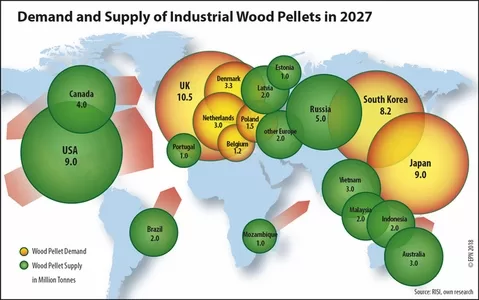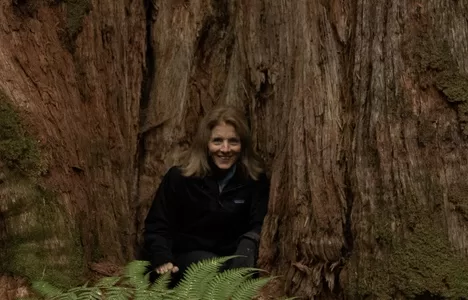It beggars belief that while the Koala and other species are facing extinction, and climate scientists are warning about the levels of carbon in the atmosphere, Australian government owned Forestry Corporations are felling native forests to make wood pellets to send to Asia so they can burn them for their electricity.
But, here we are …
Australia burns native forests for electricity
In December 2022, the new federal ALP government announced that electricity generated by burning native forest wood waste will no longer be allowed to be classified as renewable energy.
This reversed the 2015 Abbott government decision to allow burning native forest timber to be counted alongside solar and wind energy towards the national renewable energy target.
Some electricity plant owners had plans to start using native forest timber as a supplement to coal-fired generation.
Native forest logging for power generation is opposed by conservation groups, which say it is an incentive to keep felling native forests. The introduction of a transition authority to help communities affected by emissions cuts has been strongly by backed by unions and the Greens.
Suzanne Harter, Australian Conservation Foundation, said wood burning should never have been included in the definition of renewable energy.
“Eastern Australia was recently highlighted as a global deforestation hotspot. Government policies should not encourage further deforestation”
Suzanne Harter, Australian Conservation Foundation
However, in May 2023, the Australian federal government Department of Agriculture, Fisheries and Forestry website stated: “The government is aware that, to be beneficial to the environment and society, the production of biofuels and, critically, the feedstock used, must be sustainable.”
Using wood residues to produce bioenergy requires sustainable forest management to maintain environmental integrity. For this reason, the Australian and state and territory governments have put in place comprehensive frameworks to ensure that environmentally responsible forestry underpins the use of wood residues for bioenergy.
The Australian Government’s price on carbon will encourage the use of woody biomass as an energy source. The use of biomass for electricity generation or heat energy will not attract any liability under a carbon price. This means that generators that use biomass, including from wood wastes, will become more cost competitive relative to generators that use fossil fuels, which will be subject to the carbon price.
There is potential to expand Australia’s bioenergy sector to increase the use of wood residues from forest operations for electricity and heat generation and transport biofuel production.
Department of Agriculture, Fisheries and Forestry, retrieved 1 May 2023
Doubts have been raised whether native forest logging industry will remain viable in Victoria until a promised government-ordered phase out in 2030. In WA, native forest logging is due to end in 2024.
Bioenergy Australia is a government—industry forum facilitating the development of biomass for energy, liquid fuels, and other value added bio–based products.
In March 2023, Bioenergy Australia’s press release outlined their support for the Tasmanian state Liberal Party government’s continued push to develop the idea of burning forests under the guise of ‘renewable energy’:
“Modern bioenergy is one of the most widely used renewable energy sources in the world. The Bioenergy Vision sets out how Tasmania can unlock private sector investment in bioenergy in Tasmania, increasing employment, reducing waste and greenhouse gas emissions while producing more Tasmanian renewable energy’’
Minister Barnett said.
The Tasmanian state government’s Bioenergy Vision for Tasmania was released in March 2023 as Tasmania’s bioenergy vision:
To embed bioenergy as a valued renewable resource for the Tasmanian economy, community, and environment as an aid to energy production, waste management and resource recovery and reduction of greenhouse gas emissions.
Bioenergy Vision for Tasmania
See Also: Why Burn Trees to Make Electricity in the 21st Century?
Wood Pellets Threat to Climate “No Silver Pellet” Leading Scientists Warn
Native forest “residues” and “renewable energy”
NSW Department of Primary Industry issued a media release in 2017 (*1 see below) stating:
“New research suggests there are enough residues in the North Coast’s sustainably managed forests and sawmills to power more than 200,000 local homes per year.”
“The news forms part of a recent report by the NSW Department of Primary Industries (DPI), which found more than one million tonnes of forestry residues from harvesting operations could be used for bioenergy, with no adverse environmental impacts.”
2017 NSW Department of Primary Industry media release – see full PR release below
Is that correct? Almost half of these “forestry residues” come from an intensified logging regime in the public forests of north-east NSW.
Traditionally tree-falling was carried out by a chainsaw operator and individual trees were selected to be logged. In contrast, the modern method is an operator enclosed in the cabin of a harvesting machine that grabs, cuts, de-barks and moves the logs.
In order to have the clear wide arcs necessary for safe operation, all the smaller trees (up to 20 years old) that were previously left, are now removed, thus creating the ‘residues’.
The only tree retained are those few selected not to be cut.
The impacts of this intensive logging have not been assessed for their impacts on the forests, the flora and fauna, the hydrological regime or carbon storage.
While the wood is being burnt, and during the decades taken to regrow the trees, the emissions are adding to the greenhouse gases.
Further, burning wood produces approximately 50% more carbon than burning coal to produce the same amount of electricity.
The intensification agenda is a subject of bitter dispute between conservationists, forest ecologists on one side, and on the other side: the Government logging agency – Forestry Corporation. (*2 see below).
Finding a market for the ‘product’
The production of these massive amounts of ‘residue’ means a market must be found, and once again the commodity production of wood chipping subsidises the destruction of the biggest remaining trees in our public native forests, the logging of which would be uneconomical without it.
The market for native forest wood chips for pulp and paper is not as buoyant as it once was due to massive plantation estates overseas now producing a cheaper and consistent quality and colour of wood chip.
So a new market has been created for this ‘waste’ and it is burning wood chips or pellets for electricity.
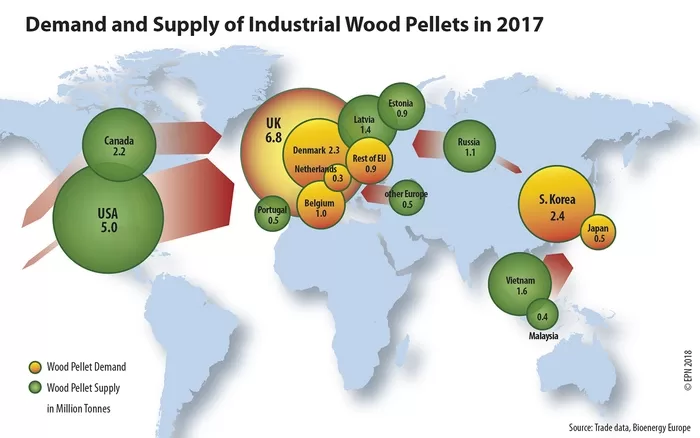
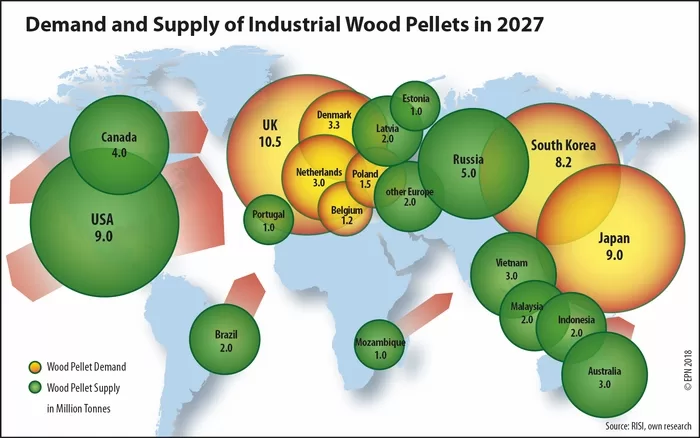

Our feature series on Native Forest logging for electricity:
1. Native forest protections are flawed, logging laws value industry over environmental protection
2. Scientists warn against harvesting forests to burn for electricity
3. Koalas & Great Koala National Park: NSW Election 2023
4. Native forest logging CO2 emissions is greater than domestic aviation
5. Threat map report shows biomass industry set to increase 250% in next decade
In north-east NSW there are two electricity generators that burn wood.
These were originally designed to run on Bagasse, they were converted to burn other sugar cane trash and Camphor Laurel, but that was unsuccessful, and now they are consuming 140,000 tonnes of wood a year and selling the electricity produced as ‘GreenPower’.
Most of this wood is coming from sawmills, clearing for road and housing developments and Managed Investment Scheme (MIS) plantations.
Many of the plantations belonged to Forest Enterprises Australia, that claimed they were planting for timber production not wood chips.
All the MIS plantation schemes went bust. Most of these cleared plantations are being converted back to pasture. So the carbon will never be re-captured by replacement trees.
The Carbon Dioxide emissions from these facilities are not counted toward any national targets or limits, because ‘biomass’ is considered to be carbon neutral.
Land is being cleared for their feedstock and it is not being replanted. Even if it were, it would be decades before the emitted carbon would be re- absorbed.
Worldwide burning of woody biomass
Burning wood for electricity is happening in Australia and overseas at huge costs to the natural environment.
The economics of it depend on the fiction that is is ‘carbon neutral’. That is, that the carbon released from the wood will be taken up by new trees.
This is only true if new trees are grown to replace those burnt, and this process can take decades to centuries according to the scientists who signed the letter to the European Union, referenced below.
Bioenergy is the largest source of ‘renewable energy’ globally, contributing over 20 per cent of energy supply in countries such as Finland and Sweden. In Sweden, bioenergy accounts for more than one-third of all energy used and biomass has provided about 60 per cent of the fuel for district heating.
This energy is produced from organic matter, including agricultural, industrial, municipal and forestry origin waste.
Scientists around the world have signed their names on documents calling for the burning of woody biomass to not be counted as carbon ‘neutral’ or renewable and not to be subsidised.
Scientists are warning about the dangers to the world’s forests and climate if this practice continues.
Bioenergy from forest biomass is not carbon-neutral and can have seriously negative climate impacts.
The combustion of forest biomass generally releases more carbon dioxide to the atmosphere than fossil fuels, because of the lower energy density and conversion efficiency of biomass (more has to be burnt relative to fossil fuels).
Conserving natural forests and old-growth forests is important for the protection of biodiversity and the mitigation of climate change.
Open letter signed by 190 scientists from the EU and US
The scale of the disaster that is wood-fired power stations is best seen in the UK, where in 2018, the massive DRAX power station burned 7.2 million tonnes of pellets made from at least 14.4 million tonnes of green wood.
By comparison, the UK’s total annual wood production was just 11.2 million tonnes.
The emissions aren’t counted, nor is the destruction of the forests in the southern USA where many of the trees were playing important roles in wetland conservation.
In the USA: BURNED – Are Trees the New Coal?
It is worth watching at least the half hour version of the documentary BURNED – Are Trees the New Coal.
BURNED is a feature-length documentary, which takes an unwavering look at the latest electric power industry solution to climate change. It can be streamed at the BURNED website.
The film tells the story of how woody biomass has become the fossil-fuel industry’s renewable, green savior, and of the people and parties who are both fighting against and promoting its adoption and use.
Japan & South Korea’s wood-fired power stations
Under the guise of “carbon neutral” energy, Japan and South Korea’s appetite for woody biomass for electricity generation has increased exponentially over the past decade and continues to grow.
The two nations’ biomass subsidies are spurring an increase in the production of wood for burning in Southeast Asia and North America, putting pressure on forests in those regions.
A trade delegation from Australia to Japan in 2018 told the Japanese that Australia had the wood to meet ‘Japan’s bioenergy needs’.
Japan is building dedicated wood-fired power stations and if Australian forests are going to meet that demand, there will be no forests left.
“More than 800 projects have already won government approval, offering 12.4 gigawatts (GW) of capacity — equal to 12 nuclear power stations and nearly double Japan’s 2030 target for biomass in its basic energy policy.”
“The sheer number of projects has raised questions about how they will all find sufficient fuel, mostly shipped in from countries like Canada and Vietnam, while some experts question the environmental credentials of such large-scale plants.”
“The projects approved to date that use general wood fuel would need the equivalent of up to 60 million tonnes of wood pellets, compared with global output of 24 million tonnes in 2014
“There will be a scramble for fuels as countries like China and South Korea are looking to expand biomass power”.
said Takanobu Aikawa, a senior researcher at Japan’s Renewable Energy Institute.
Impacts on communities
There are significant impacts on communities from these relatively small biomass projects (30MW each).
140,000 tonnes of wood in large trucks equals thousands of truck movements along small rural roads.
There have been accidents. In fact it was a truck rolling and spilling its load of wood chips that alerted locals to the problem.
The roads themselves have deteriorated and are now dangerously potholed. Locals who called a meeting to discuss the issue were sent legally intimidating letters by the trucking company. Once the failed plantations have all been burned there will be pressure from the company to get access to trees from State Forests.
Recently when the company concerned was questioned about it’s future wood supply they said ‘we’re working on it’. The problem with these facilities and others like them around the world, is that they generate demand.
They need to be fed. Otherwise jobs may be lost!
And so the cycle of destruction continues, just like the wood chipping which has done so much damage to the forests around and within trucking distance of the Eden wood chip mill. Industries like this drive deforestation and clear-felling. The wood chipping industry in Eden has converted multi-age diverse forests into largely single age regrowth with greatly diminished complexity and habitat value.
Many animal species, such as the koala, have almost disappeared as a result.
When the report was written extolling the virtues of using forest ‘waste’ for biomass burning, the DPI was the agency auspicing Forestry Corporation of NSW.
They were working hand in glove with the drive for logging intensification while touting massive wood ‘residue’ volumes to any potential buyers.
Intensification of logging in State Forests now enshrined in the new Coastal Integrated Forestry Operations Approvals. It will lead to declines in water yield, increased fire risk and declines in biodiversity.
It also leads to declines in stored carbon. With the double whammy of climate and extinction crises, we should be protecting our forests, which in turn protect our catchments, shelter our unique plants and animals and store carbon.
What must happen to stop burning biomass for fuel?
We need to move Beyond Burning!
We should reject expansion of the biomass burning industry as an energy solution.
We should condemn the proposed wood export market that will see our forests commodified with a new export wood chipping market, with massive and as yet unquantified impacts on our catchments, water security, road safety.
Burning anything, be it coal, gas, trash, or wood only perpetuates the problem of greenhouse gas emissions, as well as creating other massive environmental disasters such as the resultant land-clearing, fugitive emissions, particulate pollution, transport nightmares and biodiversity loss.
We must reject ‘solutions’ like converting wood to Bio-diesel etc. All such projects will cause long-term damage to the most efficient carbon sequestration tool we have- forests, especially mature forests.
We must look at solutions such as decentralised energy networks (like microgrids) and decentralised energy storage that can see regional areas relatively energy independent and able to contribute the electricity that many are producing towards stabilising the grid.
This can reduce the extraordinary proportion of electricity generated that is simply wasted on out-dated stabilisation techniques (1).
The Hornsdale Reserve (aka Sth. Aust. Battery) has amply proved the economics of these new techniques. The regulation of power generation was designed in the coal era and needs to be brought into the 21st Century (2).
Communities should be able to develop networks that see them independent of the national grid.
°°°°
(1) NSW DPI media release November 2017 – see below
(2) Native forest protections are deeply flawed, yet may be in place for another 20 years – The Conversation, Professor David Lindenmayer, The Fenner School of Environment and Society, Australian National University
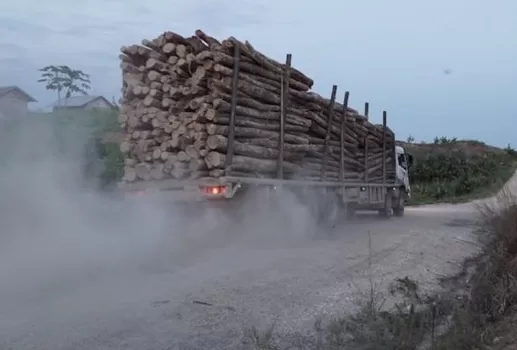

(1) North Coast forests offer untapped bioenergy opportunity
21 Nov 2017 – New research suggests there are enough residues in the North Coast’s sustainably managed forests and sawmills to power more than 200,000 local homes per year.
The news forms part of a recent report by the NSW Department of Primary Industries (DPI), which found more than one million tonnes of forestry residues from harvesting operations could be used for bioenergy, with no adverse environmental impacts.
DPI Research Scientist Fabiano Ximenes, who is presenting findings at tomorrow’s Bioenergy2017 conference in Sydney, said the two-and-a-half-year project analysed the production forests surrounding regional hubs Grafton, Kempsey and Bulahdelah.
“The research showed that there are also exciting opportunities in the production of biofuels and high-value chemicals, so there is significant untapped potential in NSW forests,” he said.
“To uncover this information, our team weighed more than 700 tonnes of biomass residues, tested hundreds of samples for nutrient and moisture content, interviewed 33 wood-processing facilities and installed more than 40 motion-sensitive cameras to observe biodiversity.”
According to the report, any potential impacts on the environment from the use of biomass can be effectively addressed by management actions; for example, via the retention of sufficient biomass in the forest to maintain biodiversity values.
“Use of the biomass for bioenergy has the potential to significantly reduce greenhouse gas emissions, due to the displacement of fossil fuels,” Mr Ximenes said.
“There are also additional benefits of removing the residues that would otherwise decay or burn in the forest, such as a reduction in forest management operational costs, reduced fuel loads and supporting regional development by creation of a new industry.”
Recent changes in state and federal legislation also now recognise bioenergy as a renewable energy source.
Mr Ximenes said NSW is well positioned to lead the nation in the adoption of bioenergy as a cost-effective and climate friendly energy solution.
“Biomass from forestry residues has great potential for large-scale electricity generation, industrial heat, biofuels and valuable natural chemicals, all within NSW regional communities,” he said.
The research forms part of the NSW Forestry Industry Roadmap initiative, delivering on Pillars 3 and 4 of ‘Community Understanding and Confidence’ and ‘Industry Innovation and New Markets’.
The NSW Government is also a sponsor of Bioenergy2017 conference. For more information or a copy of the full report visit North Coast Residues project.


